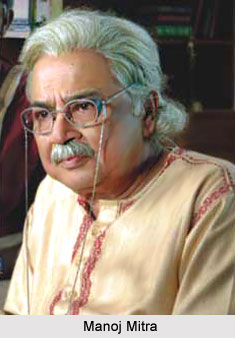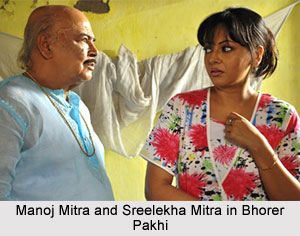 Manoj Mitra is a prominent Bengali dramatist. He was born in Khulna, East Bengal in 1938. He emerged as an all-India figure in the last capacity, with several of his works translated in other languages. His excellent character acting in many films and television serials made his face a familiar and favoured one to a wider audience in Bengal.
Manoj Mitra is a prominent Bengali dramatist. He was born in Khulna, East Bengal in 1938. He emerged as an all-India figure in the last capacity, with several of his works translated in other languages. His excellent character acting in many films and television serials made his face a familiar and favoured one to a wider audience in Bengal.
Early Life of Manoj Mitra
Manoj Mitra studied at Scottish Church College under University of Calcutta where he earned his degree in Bachelor of Arts. During his last days in college he, along with friend Parthapratim Chowdhury and others, formed a theatre group known as Sundaram.
He was also the President of Paschimbanga Natya Akademi (Government of West Bengal).
Career of Manoj Mitra
He heads the group Sundaram which was established in 1957. For this group he directs most of his plays. Probably because of his responsibility as troupe leader, as also owing to demands from friends, Mitra became the most tireless playwriting machine in contemporary Bengali theatre. He taught philosophy in colleges before joining the Department of Drama at Rabindra Bharati University, Kolkata as professor.
Although his first script came as early as Mrityur chokhejal i.e. "Tears in Death`s Eyes" in 1959, he made his presence felt with Chakbhanga Madhu i.e. "Honey Fresh from the Hive" in 1972. Bibhash Chakraborty directed this play for Theatre Workshop. It told a moving village tale in realistic style and local dialect. His next work, Narakguljar i.e. "Hell Let Loose" in 1976 was a hilarious parody of Hindu gods and gurus. This one also proved as very successful. However, Sundaram`s production of Sajano bagan which was translated as Banchhararn`s Orchard in 1977 established Mitra as a first-rate director and lead actor. It merged pleasant satire with supernatural elements in the story of an old villager whose land is coveted by the rich. Mitra`s highly popular one-act plays support sundry groups across Bengal, as well as radio and television.
 The seven landmarks of his career are, arguably, Chakbhanga madhu, Sajano bagan, the satirical Rajdarshan i.e. "An Encounter with Royalty" in 1982, the playful Kinu Kaharer thetar i.e. "Kinu Kahar`s Theatre" in 1988, the domestic melodrama Alakanandar putrakanya i.e. Alakananda`s Children` in 1989, the met theatrical Darpane Sharatshashi i.e. `Sharatshashi in the Mirror` in 1992, and the parable Galpa Hekim Saheb i.e. `Hakim Sahib`s Story` in 1994. His plays display a concern for human alienation and the cruelty of powerful classes, without simplifying his attack in a partisan manner. Parabas i.e. `Exile` in 1975, Naishabhoj i.e. "Dinner" in 1986, Shobhajatra or `Procession` in 1991, Atmagopan or "Hiding` and Chhayar Prasad or `Palace of Shadows" in 1998 maintained high creative standards. Mitra has used history, mythology, fantasy, reality, blending bright humour and pathos, with various formal innovations. His book Banchharam, theatre-e, cinemay i.e. "Banchharam in Theatre and Cinema" in 1999 narrates his personal experience with Sajano bagan and its film version, Banchharamer bagan or Garden of Banchharam in 1980. In that play he recreated his role.
The seven landmarks of his career are, arguably, Chakbhanga madhu, Sajano bagan, the satirical Rajdarshan i.e. "An Encounter with Royalty" in 1982, the playful Kinu Kaharer thetar i.e. "Kinu Kahar`s Theatre" in 1988, the domestic melodrama Alakanandar putrakanya i.e. Alakananda`s Children` in 1989, the met theatrical Darpane Sharatshashi i.e. `Sharatshashi in the Mirror` in 1992, and the parable Galpa Hekim Saheb i.e. `Hakim Sahib`s Story` in 1994. His plays display a concern for human alienation and the cruelty of powerful classes, without simplifying his attack in a partisan manner. Parabas i.e. `Exile` in 1975, Naishabhoj i.e. "Dinner" in 1986, Shobhajatra or `Procession` in 1991, Atmagopan or "Hiding` and Chhayar Prasad or `Palace of Shadows" in 1998 maintained high creative standards. Mitra has used history, mythology, fantasy, reality, blending bright humour and pathos, with various formal innovations. His book Banchharam, theatre-e, cinemay i.e. "Banchharam in Theatre and Cinema" in 1999 narrates his personal experience with Sajano bagan and its film version, Banchharamer bagan or Garden of Banchharam in 1980. In that play he recreated his role.
Life in Cinema for Manoj Mitra
Manoj Mitra has worked under diverse variety of directors like Buddhadeb Dasgupta, Basu Chatterjee, Tapan Sinha, Satyajit Ray, Tarun Majumdar, Shakti Samanta and Goutam Ghose.
He is well known for his great role in Tapan Sinha`s film Banchharamer Bagaan, where he played the role of gardener, which was based on Mitra`s play Sajano Bagaan (The arranged garden)




